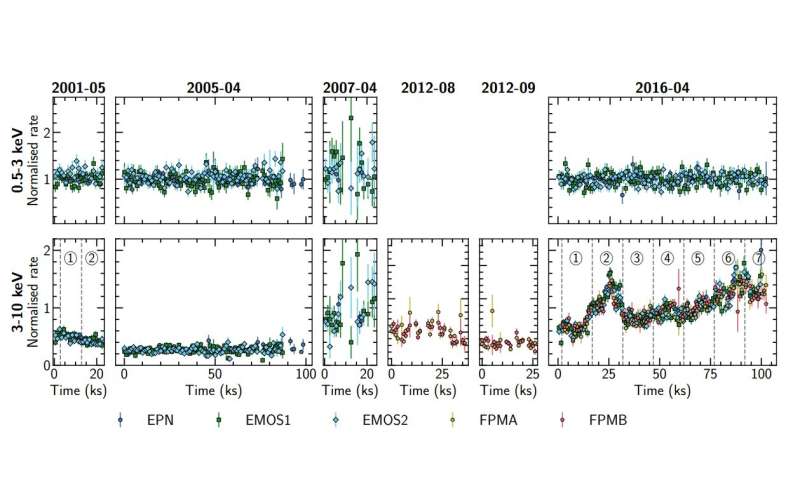April 7, 2023 report
This article has been reviewed according to Science X's editorial process and policies. Editors have highlighted the following attributes while ensuring the content's credibility:
fact-checked
preprint
trusted source
proofread
Astronomers investigate X-ray spectral variability of active galaxy NGC 7582

Using ESA's XMM-Newton and NASA's NuSTAR space telescopes, astronomers have observed a nearby active galaxy known as NGC 7582. Results of the observational campaign, published March 30 on the arXiv pre-print server, shed more light on the X-ray spectral variability of NGC 7582's active galactic nucleus (AGN).
An AGN is a compact region at the center of a galaxy, more luminous than the surrounding galaxy light. Studies show that AGNs are very energetic due either to the presence of a black hole or star formation activity at the core of the galaxy.
Astronomers generally divide AGNs into two groups based on emission line features. Type 1 AGNs show broad and narrow emission lines, while only narrow emission lines are present in Type 2 AGNs. However, observations revealed that some AGNs transition between different spectral types; therefore, they were dubbed changing-look (CL) AGNs.
At a distance of some 73 million light years away from the Earth, NGC 7582 is a Type 2 Seyfert galaxy with a changing-look AGN. The galaxy has a diameter of about 100,000 light years and a supermassive black hole at its core with a mass of about 55 million solar masses.
Now, a team of astronomers led by Mehdy Lefkir of the University of Leicester, U.K., have analyzed the available observational data of NGC 7582 obtained with XMM-Newton and NuSTAR between 2001 and 2018. The main aim of their study was to explain the short- and long-term X-ray behavior of this source.
"To study the variability, we perform a time-resolved spectral analysis using a phenomenological model and a physically-motivated model (uxclumpy). The spectral fitting is achieved using a nested sampling Monte Carlo method. Uxclumpy enables testing various geometries of the absorber that may fit AGN spectra," the researchers explained.
It turned out that NGC 7582 exhibits a long-term variability between observations conducted by Lefkir's team but also a short-term variability in two observations that has not been studied before. The astronomers found that the long-term and short-term variability are due to intrinsic changes in the X-ray luminosity of the source, and changes in the absorption in the line of sight.
According to the paper, this absorption is best described by a fully covering clumpy absorber. The researchers noted that the short-term variability of NGC 7582 could be explained by a spherical clump with a density profile peaking in the core and slowly decreasing towards the surface of the clump.
The results suggest that the absorber is located at a distance not larger than 1.95 light years from the X-ray source, moving with a transverse velocity exceeding approximately 700 km/s. Assuming that the absorber is a single cloud in the line of sight, the size of this cloud is estimated to be larger than 100 million kilometers.
All in all, the observations indicate the presence of a variety of cloud densities, or even a gradient in the density within a single cloud. This, according to the authors of the paper, favors a comet-shaped cloud scenario or at least a non-uniform cloud.
More information: Mehdy Lefkir et al, A hard look at the X-ray spectral variability of NGC 7582, arXiv (2023). DOI: 10.48550/arxiv.2303.17473
Journal information: arXiv
© 2023 Science X Network





















